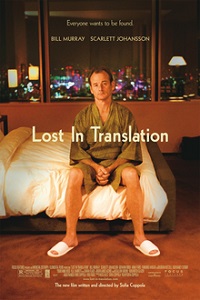
Lost in Translation is a 2003 film directed by Sophia Coppola and starring Bill Murray and Scarlett Johansson. From 1998’s Rushmore onwards, Murray transitioned into more dramatic roles and this is already one of his best remembered since this transition. The film also launched the career of Johansson who was only a teenager at the time. While it is certainly an excellent film in its own right, the backdrop of Japan became a focus for much of the films audience including this writer.
It is really important to emphasise this despite being clearly signaled in the title. The country of Japan is only a backdrop that allows the characters in the story to form a relationship. Both characters are in unhappy marriages. Murray’s character Bob, who’s wife is just a voice on the other end of a phone line, is interested only in home renovation and her children (as the latter should be). Johansson’s Charlotte is a young newlywed (much younger than I realised at the time), to a career focused but sincere man. Thinking about it, neither character is in a dysfunctional or abusive marriage, they just have little emotional connection with their spouses and this coupled with the isolation they feel within a sterile Tokyo hotel leads to a friendship and whether it ever became more is left to the audience.
On the subject of whether or not they would have formed a relationship, I would like to imagine that they didn’t. The two are very oddly matched and at the time I saw Bob as more of an older mentor than a potential lover who would have gone back to his family in the end. Murray is well over thirty years older than Johansson and the connection they had blossomed more out of the differences in the world they met each other in than out of any genuine attraction. It is doubtful this would have lasted once they had returned to their homeland.
Indeed, most people who have travelled or have found themselves in odd situations with strangers can attest to relationships forming out of them. When I first went to Japan, someone from the group I bonded with pointed this out directly. She knew we would never have become friends had we not been put together in a foreign country. Although I would be happy to see her again, I don’t have such a strong feeling that I would seek her out and I couldn’t easily contact her now if I wanted to.
This brings us to what most people I have discussed the film with seemed to latch on to — Japan. A couple of years ago I read The Remains of the Day by Kazuo Ishiguro This was a very good book and the focus is around the relationship that develops between two servants in an English manor. There are strong hints of Mr. Stevens and Miss Kenton having strong affection for each other but it never blossoms and the latter ultimately leaves to marry someone else. This isn’t a spoiler as most of this is revealed in the beginning of the book. The film adaptation with Anthony Hopkins and Emma Thompson has a much stronger focus on the background involving the owner of the manor being sympathetic to National Socialist Germany. This dilutes the real focus of the novel which is on the relationship between the two servants. This is an odd aside but this applies to Lost in Translation where most people found the background far more fascinating than the characters.
This is not to attack the leads or even the writing which I still find authentic on each re-viewing. But it is hard even today but Japan and the Japanese really do steal the show. The film certainly influenced my desire to visit the country and there are plenty who would say the same thing. At least two of my acquaintances quickly sought out Suntory whiskey shortly after arriving in Japan. The business-minded Japanese were no doubt, very pleased with the films influence on tourism.
Having lived in the country as long as I did, the film captures more of the urban corporate Tokyo environment as well as some of the bohemian youth you do find in pockets of major cities. Picturesque trips to Kyoto, neon jungles and silly television aside, the film ultimately gives a limited image of the nation as it is. All that said, what is shown is not at all inauthentic, it just isn’t the full picture and I would warn potential visitors off expecting the kind of carnival the characters experience in multiple vignettes throughout the film.
There was a short time after living in Japan for a few years that I started to fancy the film was offensive to the Japanese. This was based on a better understanding of Japanese manners and customs but some viewings since have laid those criticisms to rest. There is no judgement in any of this and the characters (and I believe the director herself), seem to have genuine affection for the Japanese. And once again, I need to remind myself that Japan was the backdrop and the same story could have been told between two Americans in Paris. The latter has just been done to death.
As you can probably gather, I have watched the film many times. I would say less than ten but certainly more than five. I’m not quite sure but enough to make it one I can hardly say I don’t enjoy though I’ve never considered it a favourite. Watching it today and understanding what is meant to be alien to much of the audience (including the language), it still makes for entertaining viewing. If nothing else, it certainly influenced the direction my life took which is not something I could say about many novels let alone films.
